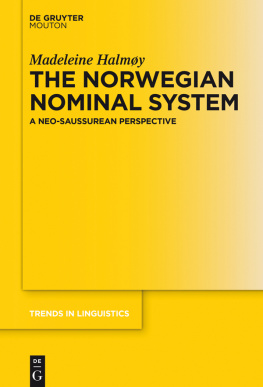The Norwegian Nominal System
Guide

Madeleine Halmy
The Norwegian Nominal System
Trends in Linguistics Studies and Monographs
Editor
Volker Gast
Editorial Board
Walter Bisang
Jan Terje Faarlund
Hans Henrich Hock
Natalia Levshina
Heiko Narrog
Matthias Schlesewsky
Amir Zeldes
Niina Ning Zhang
Editor responsible for this volume
Volker Gast
Volume 294

ISBN 978-3-11-033963-5
e-ISBN (PDF) 978-3-11-036342-5
e-ISBN (EPUB) 978-3-11-039478-8
ISSN 1861-4302
Library of Congress Cataloging-in-Publication Data
A CIP catalog record for this book has been applied for at the Library of Congress.
Bibliographic information published by the Deutsche Nationalbibliothek
The Deutsche Nationalbibliothek lists this publication in the Deutsche Nationalbibliografie; detailed bibliographic data are available on the Internet at http://dnb.dnb.de.
2016 Walter de Gruyter GmbH, Berlin/Boston
www.degruyter.com
Acknowledgements
This book contains just minor changes and corrections to my PhD-dissertation, defended at CASTL, The Faculty of Humanities, Social Sciences and Education at the University of Troms (now UiT Norwegian Arctic University) in April 2010. Six years have passed since my defence at the time I am writing this, and I want to thank all who read this and know why it has taken so long, for your support.
I am grateful to my committee Greville Corbett, Helge Dyvik and Marit Westergaard for their comments, questions, discussions and suggestions. Helge Dyvik has been willing to meet and discuss with me on several occasions also after the defence, and I want to thank him especially for his encouragements and interest in my work. For reading parts of or the entire thesis and providing valuable comments, or just letting me know you enjoyed it, I also thank Bruce Morn-Duollj, Trond Trosterud, Terje Lohndal, Marit Julien, Martin Krmer, Torodd Kinn, Helge Ldrup and Christine Bjerkan stbe. I am especially indebted to series editor Volker Gast and an anonymous reviewer. Though I have not been able (or willing) to accommodate all your suggestions, you have all not only made me rethink my work and choices, something that often led to clarifications both in my thinking and writing, but also given me inspiration to keep going. When working in a minority program, interest and encouragements from so many highly respected colleagues with such diverse orientations both theoretically and empirically are especially welcome. For encouraging me to publish, I thank Tore Nesset, Endre Mrck, Terje Lohndal, Martin Krmer, Helge Dyvik, Curt Rice and Marit Julien.
Highlights of the thesis were also presented at NO2014s Juleseminar at the University of Oslo in December 2010 and at the seminar Ferdinand de Saussure (18571913) hvor str Saussureforskningen 100 r etter hans dd? at the University of Bergen in May 2013; I thank the organisers of these events for inviting me, and the audiences for their interest, questions and comments.
Though the analyses are not radically changed, the language and rhetoric have gotten a necessary makeover. Marina Pantcheva made valuable comments on the first two chapters, Martin Krmer has added quite a few commas and corrected numerous agreement mistakes and typos, and thus made Joe Collinss work as a proof reader a little bit easier. I also thank The Department of Linguistics at UiT for paying Joe to do this work.
I am also thankful to my contacts at the Gruyter, series editor Volker Gast, Birgit Sievert, Julie Miess and Olena Gainulina for answering all my questions, and especially for their encouragements and patience each time my editing work was postponed.
While most of the work on this project was done during my time in Troms, the final editing has been performed at my new job at Sogn og Fjordane University College. I thank my new colleagues and my lovely neighbours in Fimreite for their warm welcome.
Finally, I want to dedicate this book to my three linguistics teachers and mentors Tor farli, Tore Nesset and Denis Bouchard. Without Tors teaching and his, from the beginning of, insistence that I should trust my thinking and do things my own way, I would never have become a linguist or started a Ph.D.. Without Tores supervision, support and encouragements on both the professional and personal level, I would never have finished the thesis or managed to stay in the field these years after the defence. Without Denis inspiring theory, this work would never have been conceived, and without his warm welcome and our inspiring discussions during my two years at UQAM, it would never have been born. You are three very different scholars and personalities, working in three different frameworks, but you share a rare openness to the field and respect for other peoples thinking and work. The more I have gotten to know you, both on a professional and personal level, the more I admire you and the more grateful I am to have had the chance to work with you.
The strengths of this work owe much to others; the shortcomings are mine alone.
Fimreite, May 2016
Madeleine Halmy
Abbreviations
| CG | common gender |
| COMP | comparative |
| C-sign | combinatorial sign |
| DEF | definite |
| Deix | deixis |
| Dem | demonstrative |
| F | feminine |
| GN | general number |
| INDEF | indefinite |
| M | masculine |
| N | neuter |
| Nom | nominative |
| Obl | oblique |
| P | person |
| PL | plural |
| Poss | possessive |
| Prox | proximal |
| Refl | reflexive |
| SG | singular |
| SUP | superlative |
| U-sign | unitary sign |
List of tables, figures and grammatical definitions
1Introduction
This study presents a unified, economic account of the intricate relationship between form, meaning and interpretation in the Norwegian Nominal System, in its own right and on its own terms. On the basis of a parsimonious set of theoretical principles, which all follow from the fact that languages are systems of radically arbitrary signs (Saussure 1916), the Neo-saussurean approach yields insightful, though simple, descriptions and explanations of an extensive range of data. By keeping a strict distinction between invariant meaning and contextual interpretation, the featural values of the most important lexical, functional and syntactically complex signs in the system are reanalysed, and this search for context independent meanings results in featural polysemy being abolished from the Norwegian Nominal System altogether.
The study offers several contributions in the analysis of the different signs that constitute the Norwegian Nominal System. The most radical proposal in this respect is the demonstration that the truly bare noun in Norwegian cannot be understood as singular indefinite, but rather carries general number in the sense of Corbett (2000). The general number feature will also be proposed for adjectives ending in -e . The introduction of the value general number into the Norwegian Nominal System has a number of consequences for the understanding of the system as a whole, one particular advantage being that it offers a neat and economic picture of the featural distribution in attributive adjective-noun constructions.










